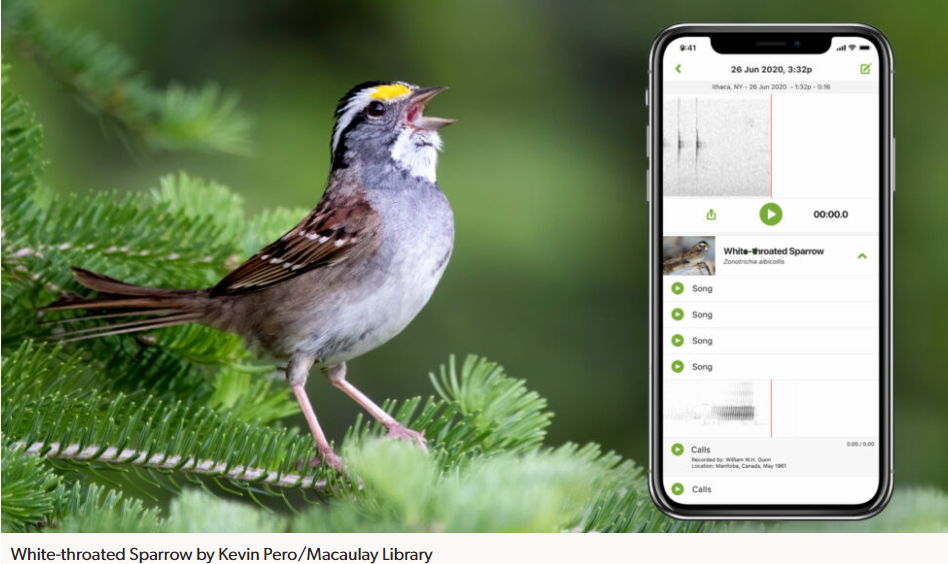Merlin Sound ID: How to Merlin Mindfully

If you’ve never played around with it, the Merlin Bird ID (Google Play/App Store) is a rather amazing app for your smartphone that identifies bird songs in real time.

There are a lot of benefits to this, as it’s a great way for new birders to start learning about bird calls and realizing what birds are around. If you are traveling, it can alert you to calls of species that you might not be familiar with. Even for experienced birders, it can sometimes alert you to species that you may have otherwise not heard.
But here’s the thing: IT’S NOT PERFECT. If you assume it is 100% accurate and add every bird Merlin suggests into your eBird checklist, it can get you into trouble.
Ask an eBird reviewer who processes flagged records what they think of this tool and you may be more likely to hear groans than applause.
The accuracy rate of Merlin overall probably depends on location and habitat, but if you assume it’s 80% accurate, then 2 of 10 birds it identifies is wrong. Which means if you go birding and it suggests 30 species for you, then 6 of those 30 species are wrong.
So we suggest Merlining Mindfully! Do not just report every bird that Merlin suggests!
Endeavor to get a look at every species it suggests, especially if that species is unusual.
Here are some tips, based on our experience, of what Merlin is good at and struggles at.
Merlin Excels at:
Common Species
Merlin is only as good as the information that has been fed to it. As such, it seems to be much more familiar with common species than rare ones.
Species with very regular songs and calls
Songs that are always the same, think Black-throated Green Warbler or Eastern Phoebe, seem to be easy for it.
Chip notes/Night flight calls
Merlin is surprisingly good at short call notes, and can return accurate results for things like Savannah Sparrow and Yellow Warbler, which often very good birders can recognize but fly under the radar of many birders.
Merlin Struggles with:
Variable songs
Songs with complex structure, lengthy songs, birds that mimic other species, songs and calls that are more plastic and less consistent. Here is a partial list of some species that are occasionally problematic.
Mimids
Gray Catbird
Northern Mockingbird
Brown Thrasher
Other species that mimic
European Starling
Blue Jay
Trillers (sometimes)
Worm-eating Warbler
Chipping Sparrow
Dark-eyed Junco
Pine Warbler
Confusing Warblers
American Redstart
Yellow Warbler
Chestnut-sided Warbler
Finches
American Goldfinch/Redpoll
Similar sounding calls when ranges are overlapping
Philadelphia Vireo/Red-eyed Vireo
(Merlin was confusing Philadelphia Vireo with Red-eyed Vireo so often that it has now been removed as an option)
Species that can have variable calls or scolding calls
Barred Owl
Eastern Meadowlark
Carolina Wren
Species with geographic variation (mostly outside Wisconsin, but at the moment Merlin doesn’t distinguish between regions for a species)
Eastern vs. Western Warbling Vireo
Song Sparrow subspecies
Uncommon vocalizations
If you are hearing an alternate or not often heard vocalization, Merlin may not register it, or may confuse it with something else.
Rare species
Merlin uses the bar chart from your location to filter records. Many rare species may not come up at all. If your location is set correctly, in many cases the system intentionally does not even report these as results. In some cases it will suggest a call is a more common species. Conversely, one instance of a rare species in a bar chart for your time window may open up Merlin to consider rare species more possible than they are. Or in areas where checklist filters are a little loose, Merlin could report unlikely species.
Data-poor Areas
Across much of the United States, Merlin “knows” most of the species, but in other countries or in areas of the United States where the bar chart is thinner, Merlin has less to work with and may be less accurate.
What Should You Do?
We aren’t anti-Merlin, it’s a really fun and potentially very useful tool. You should just Merlin Mindfully!
- Make sure Merlin has permission to see your location
- Try to get a look at any unusual species reported by Merlin
- Don’t report species that were only detected by Merlin
- “Merlin IDed it” is NOT a valid comment for a flagged record
- But please do attach the Merlin audio to your checklist! Recordings help train Merlin — the most useful ones are longer than 30 seconds with at least 5 calls from the focal species.
- “Merlin IDed it 20 times” is not any more useful — when Merlin is being tricked, it can get tricked repeatedly
- If you enter a species on your checklist and it is flagged as rare, stop and think whether you saw that species or it was only Merlin that suggested it
- You can improve your odds of a good recording by getting close to a bird and standing still, see other Merlin Sound ID best practices
Ultimately, Merlin is a tool, and tools can be misused. Instead, use it to make you aware of potential species in the area, to learn songs and calls of the birds around you, and help you visually find more species. But please don’t blindly submit its outputs to your eBird checklists.
Thank you, and happy Merlining!
